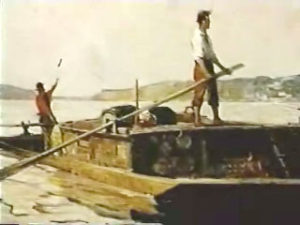 Soon after moving to Illinois, Lincoln made his second flatboat trip to New Orleans. A local entrepreneur and schemer named Denton Offutt approached Lincoln’s relative John Hanks about manning such a journey. Hanks then recruited Lincoln and brother-in-law John Johnston, all of whom now lived in a wooded area west of Decatur near the banks of the Sangamon River. Because of the previous “winter of deep snow,” melting snowpack made the roads impassable by the first of March 1831, forcing the three men to purchase a canoe and paddle down the Sangamon River as far as Springfield, where they expected to find a fully loaded flatboat. Offutt, however, had somehow forgotten to arrange for it.
Soon after moving to Illinois, Lincoln made his second flatboat trip to New Orleans. A local entrepreneur and schemer named Denton Offutt approached Lincoln’s relative John Hanks about manning such a journey. Hanks then recruited Lincoln and brother-in-law John Johnston, all of whom now lived in a wooded area west of Decatur near the banks of the Sangamon River. Because of the previous “winter of deep snow,” melting snowpack made the roads impassable by the first of March 1831, forcing the three men to purchase a canoe and paddle down the Sangamon River as far as Springfield, where they expected to find a fully loaded flatboat. Offutt, however, had somehow forgotten to arrange for it.
Frustrated by the delay but eager to continue, Lincoln, Hanks, and Johnston were joined by a local carpenter, Charles Cabanis, and John Roll. While they largely followed the standard design, there were some differences. Because this trip was to include livestock—live hogs in addition to wet and dry goods—the men constructed small corrals and troughs in the boat. They also added a wooden mast and sail to help them maneuver when the wind was gentle enough to push the boat, but not wreck it. After about six weeks of construction, they shoved the 18 feet wide by 80 feet long boat into the Sangamon River just below Sangamotown. They floated the Sangamon River as it wound northwest until meeting the Illinois River near Beardstown, which then turned south until its confluence with the mighty Mississippi River north of Alton for their final thousand miles on the waters to New Orleans. Along the way they would pass St. Louis (where John Hanks turned back because his wife was due to give birth), Memphis, Vicksburg, Natchez, and Baton Rouge, giving Lincoln a glimpse at cities that would become important strategic points in the later Civil War.
As he moved down the river, Lincoln discovered how the Mississippi had become the central artery of commerce in the Midwest, allowing farmers from western New York, Ohio, Indiana, and Illinois to move their produce to New Orleans. It was here Lincoln discovered the existence of a cosmopolitan, multiethnic, society doing trade with the Caribbean and South America, as well as across the central American isthmus and up to west coast, plus Europe and Africa. Lincoln’s world enlarged immeasurably. No longer subsistence farming and small towns as far as you could walk or ride on horseback, life on the river showed Lincoln a glimpse of upper society. There were wealthy sugar plantation owners who purchased or traded for pork and potatoes. There were poverty-stricken families, both black and white, desperate to barter whatever little they had for whatever little they could get. The river was an economic engine as well as transportation, but he recognized the benefits were unequal in distribution. It made Lincoln think about his own situation, his limited formal schooling and opportunities, and how he might better his condition.
Upon arrival in the Crescent City, he and his companions had to compete for space at the piers with hundreds of other flatboats, two to three deep along the docks for over a mile at the landing site above the city. After crawling over other boats, the men bartered and sold whatever remained of their wares, plus anything acquired along the way. Eventually they would sell the boat itself, sometimes whole to a wealthy buyer, but often piecemeal, taking it apart board by board to sell as lumber or fuel. Overall, they could net a return of about a quarter of the construction cost. On each occasion the crews lingered in New Orleans for as long as they could afford before setting out for home.
[Adapted from my forthcoming book]
David J. Kent is the author of Lincoln: The Man Who Saved America. His newest Lincoln book is scheduled for release in February 2022. His previous books include Tesla: The Wizard of Electricity and Edison: The Inventor of the Modern World and two specialty e-books: Nikola Tesla: Renewable Energy Ahead of Its Time and Abraham Lincoln and Nikola Tesla: Connected by Fate.
Follow me for updates on my Facebook author page and Goodreads.



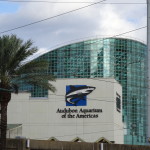 Many years ago,
Many years ago, 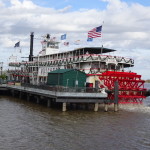 Yes, the allusions in the title are intentional. Creedence Clearwater Revival (aka, CCR) wrote a
Yes, the allusions in the title are intentional. Creedence Clearwater Revival (aka, CCR) wrote a  Book Review – Lincoln in New Orleans by Richard Campanella
Book Review – Lincoln in New Orleans by Richard Campanella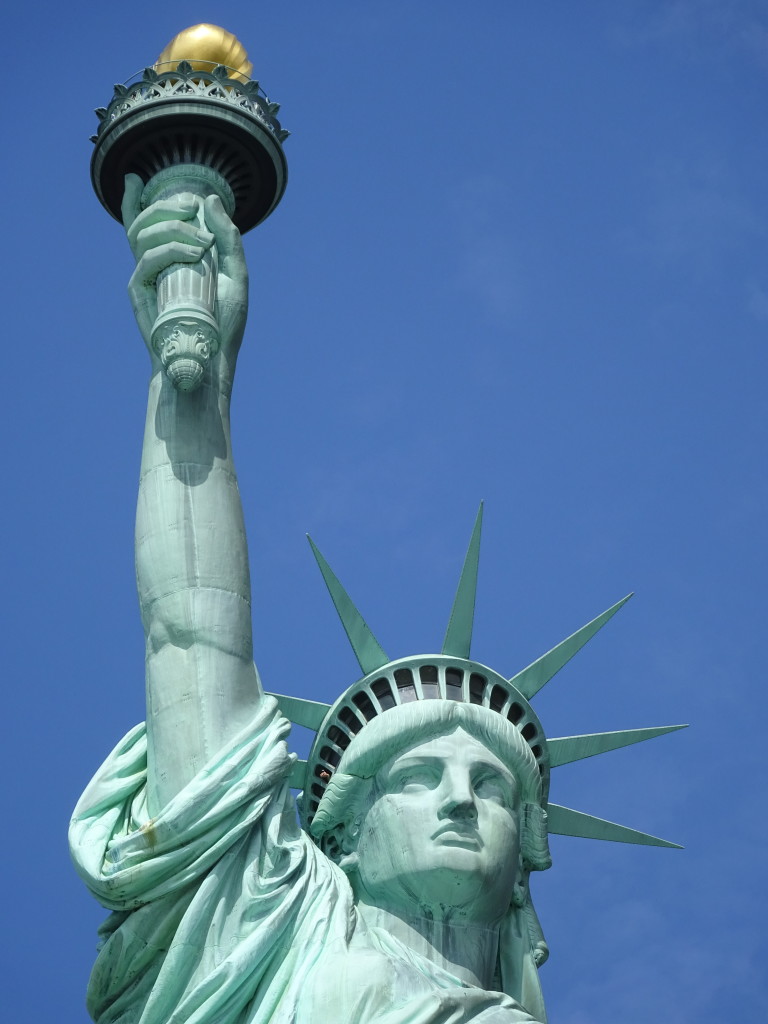
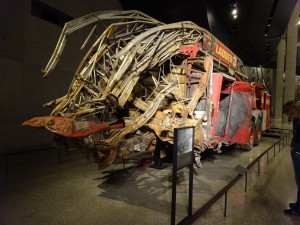 Tesla) circled the boat, we stopped at Ellis Island on the way back, just long enough to remind us that immigration is the fabric of our nation. From there we visited One World Trade Center, called “Freedom Tower” by many. Sitting on the site of the World Trade Towers that fell September 11, 2001, the new building overlooks two reverse pools surrounded by the names of those lost. A museum brings you down into the nightmare that was that day, and also the heroism. It’s a must visit.
Tesla) circled the boat, we stopped at Ellis Island on the way back, just long enough to remind us that immigration is the fabric of our nation. From there we visited One World Trade Center, called “Freedom Tower” by many. Sitting on the site of the World Trade Towers that fell September 11, 2001, the new building overlooks two reverse pools surrounded by the names of those lost. A museum brings you down into the nightmare that was that day, and also the heroism. It’s a must visit.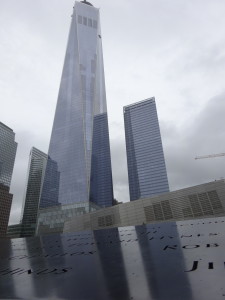
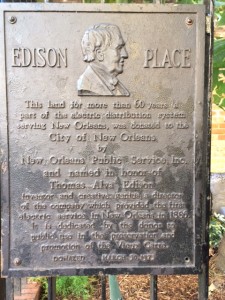 After hosting the Thanksgiving visit the only trip left on the calendar this year is a 4-day weekend in New Orleans. I’ve never been there. After lobbying SETAC for ten years to hold a meeting there they finally scheduled one – for the time that I was working in Brussels and my company refused to allow me to come back for it. I’m looking forward to it, especially now that I know there is a plaque highlighting Thomas Edison in the French Quarter.
After hosting the Thanksgiving visit the only trip left on the calendar this year is a 4-day weekend in New Orleans. I’ve never been there. After lobbying SETAC for ten years to hold a meeting there they finally scheduled one – for the time that I was working in Brussels and my company refused to allow me to come back for it. I’m looking forward to it, especially now that I know there is a plaque highlighting Thomas Edison in the French Quarter. An exceptionally well researched book recreating Abraham Lincoln’s flatboat trips to New Orleans. Campanella is an expert on New Orleans, and has expanded his expertise upstream to develop a detailed account of Lincoln’s two trips down the Mississippi River. No small feat given that the sum total of all the first person reminiscences of the trips by Lincoln and participants wouldn’t fill a page of text. Campanella’s recreation, like many efforts based on such scant direct information, is not however contrived in the least. On the contrary, the effort he has put into collecting and analyzing fragmented – and often contradictory or dubious – accounts is exemplary.
An exceptionally well researched book recreating Abraham Lincoln’s flatboat trips to New Orleans. Campanella is an expert on New Orleans, and has expanded his expertise upstream to develop a detailed account of Lincoln’s two trips down the Mississippi River. No small feat given that the sum total of all the first person reminiscences of the trips by Lincoln and participants wouldn’t fill a page of text. Campanella’s recreation, like many efforts based on such scant direct information, is not however contrived in the least. On the contrary, the effort he has put into collecting and analyzing fragmented – and often contradictory or dubious – accounts is exemplary.






